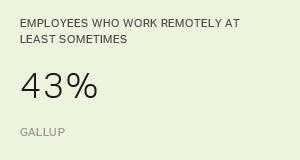Story Highlights
- Loneliness is emotional and isolation is structural
- Managers need to know the difference to help remote workers thrive
- A strategy of engagement can help managers keep remote workers connected
Despite the productivity gains and cost savings associated with remote work, many leaders worry that those advantages come at the expense of remote workers' emotional health -- in particular, that remote work causes loneliness and isolation. Ultimately, it's feared, remote workers' engagement and productivity will suffer.
Gallup finds that remote workers can feel lonely and isolated -- but it's not typical and it is preventable. In fact, a recent Buffer study of 1,900 remote workers around the world found that 90% intend to work remotely for the rest of their lives and 94% recommend off-site careers. And when asked to name the biggest struggle with working remotely, just 21% named "loneliness."
Still, one-fifth of a workforce is a lot of people, and leaders need measures in place to fix that problem before it damages engagement and performance. Gallup research shows that managers are best positioned to implement the strategies that make the biggest difference for their teams -- but first, they have to know the difference between loneliness and isolation.
Loneliness is emotional. Isolation is structural.
First, it helps to understand that loneliness is an emotional response to lack of connection -- and people can feel just as lonely in the office as outside of it. One quasi-field experiment conducted at a global headquarters that was transitioning to open office workstations documented an interesting phenomenon. Instead of the open floorplan encouraging collaboration, the study found the volume of face-to-face interaction between employees decreased by approximately 70%, while electronic communication increased. Employees appeared to react to the workspace by socially withdrawing from peers and partners to interact over email and IM instead.
Isolation, on the other hand, is related to access -- or lack of it. Employees dealing with isolation at work can't get the materials or information they need, they think their achievements or development are ignored, they feel cut off from the business. That isn't an emotional issue, it's a technical one.
This is a manager's top priority -- having the materials and equipment you need to do your work right is fundamental to engagement.
Loneliness can contribute to isolation and isolation can contribute to loneliness, but managers can address both by talking about the issues that cause them. Gallup workplace research recommends frequent, ongoing conversations -- in fact, we recommend five distinct types of conversations that drive performance, each timed for maximum impact -- but with specific language framed for remote workers: "I need to know how you're getting along. So tell me, is it too quiet at home? Do you miss having people around? Do you feel left out?"

Direct questions get direct answers, and managers should be prepared with appropriate solutions to ensure a healthy work environment. Here's what Gallup recommends, geared toward the individual and the issue.
Only the Lonely: How to Help Your Remote Workers
If the worker's answers indicate they are dealing with loneliness, the manager's strategy must reflect the worker's personality. If he's lonely because he's shy, trying to turn him into a social butterfly is a waste of the manager's time and the worker's patience. A better bet is creating low-stakes opportunities for meaningful connections, but the manager should take the lead -- making formal introductions to colleagues, accepting the emotional labor of pre-meeting small talk, linking him with partners for projects.
If the worker is more outgoing, his manager just needs to help him open his office door, metaphorically, to visitors. Online group chats allow teams a kind of ongoing hallway chatter. Managers can set up weekly "phone trees" for remote workers organized around a workplace topic. Managers can even send remote workers a list of local coffee shops along with a small gift card: "You need to be around people to keep your energy up. Get a cup of coffee and have a great workday."
In any case, managers who ask lonely employees for their opinions can gain some valuable insight. Opinions are especially fruitful post-project or at the achievement of a milestone -- reflection helps workers process learning opportunities -- yet remote workers may feel their perspective is so narrow that their opinion isn't needed.
When managers can meet the basics needs of engagement, even casual, friendly conversations turn into innovative discussions that help the team and organization thrive.
In fact, remote workers' perspectives can provide rare insights into the organization. Shy, lonely workers need to hear they offer unique value -- it can ease social anxiety -- and outgoing, lonely workers need more contact. Either way, their insights on the work environment can bring to light connections they ought to make, as well as show managers new ways to improve processes.
Out of Sight, but Not Out of Mind
Employees dealing with isolation while working from home need a more tactical approach, but it requires a judicious balance. Remember, some people choose remote work because isolation boosts employee productivity. IBM learned this the hard way. In 2009, IBM reported that 40% of its workforce (386,000 employees in 173 countries) worked remotely. In 2017, after 20 straight quarters of losses IBM's leadership decided that it needed to generate more serendipitous ideas from its employees. So "Big Blue" called in its remote workers to boost collaboration and innovation.
It didn't work. Those remote employees who loved to work remotely immediately began searching for new jobs that would continue to allow them to work from home. Those who did return to an office deliberately isolated themselves, possibly to recreate the environment that had best suited them -- research has demonstrated as much in other workplaces. It's a cautionary tale for managers: The isolated aren't sad, they're cut off. Managers can fix that by integrating remote workers deeper into the organization, despite their distance.
For instance, managers can bring a list of their remote workers to strategic meetings, annotated with their CliftonStrengths if available, to help the manager's recall when projects are being planned. That keeps remote workers visible and their advancement, development, and recognition top of mind. Managers can make time with their own managers to specifically discuss the engagement of remote workers and ways to help them learn and grow.
If remote workers can't access the materials and equipment they need, managers should work with departments that can solve the problem, such as IT or legal. Cybersecurity can be an obstacle, but tech is increasingly capable of keeping employees in the loop on secure channels. This is a manager's top priority -- having the materials and equipment you need to do your work right is fundamental to engagement and creating an ideal work environment.
And remote workers who simply feel left out can really benefit from being brought in, physically. And as one Gallup manager of remote workers says, there's always a business case to be made for in-person meetings at HQ, even if the purpose is as much social as practical. Or borrow a page from university alumni chapters' regional meetups and organize remote-worker get-togethers somewhere central to them. It's a cost-effective way to keep relationships alive and far-flung teams highly engaged, as any alumni director can tell you.
Employee Engagement as an Organizing Principle
Supporting the unique needs of remote workers may seem like a lot of work for a manager. It can be. Though the best managers are masters of individualization, staying on top of the psychological welfare and work environments of remote employees takes time and concern.
It helps to use the elements of engagement as an organizing principle. The five conversations that drive performance are oriented toward engagement, and they keep managers focused where their attention most helps performance. Those conversations also give managers time and opportunity to really understand remote employees. To consider their unique contributions. To watch how they like to communicate. To discover how they respond to workplace situations. To understand loneliness when they see it or isolation for what it is.
When managers can meet the basics needs of engagement, even casual, friendly conversations turn into innovative discussions that help the team and organization thrive. That's what leaders want from remote workers, of course, and they're right to worry that loneliness and isolation may get in the way.
They can -- but they don't have to. Not if managers know the difference between loneliness and isolation and have the tools they need to solve for both.
Explore more resources for supporting remote workers:
- Read about "The Changing Place and Space of Work" in Gallup's State of the American Workplace report which includes research on remote work trends and best practices.
- Learn strategies for adapting to the future of work including new demands for flexibility with Gallup's latest book, It's the Manager.
- Attend the free webinar "Managing Your Remote Workers" and learn more about the intentionality and deliberate communication that managing remote workers requires.
- Partner with Gallup to equip managers to have coaching conversations that improve employee performance.







